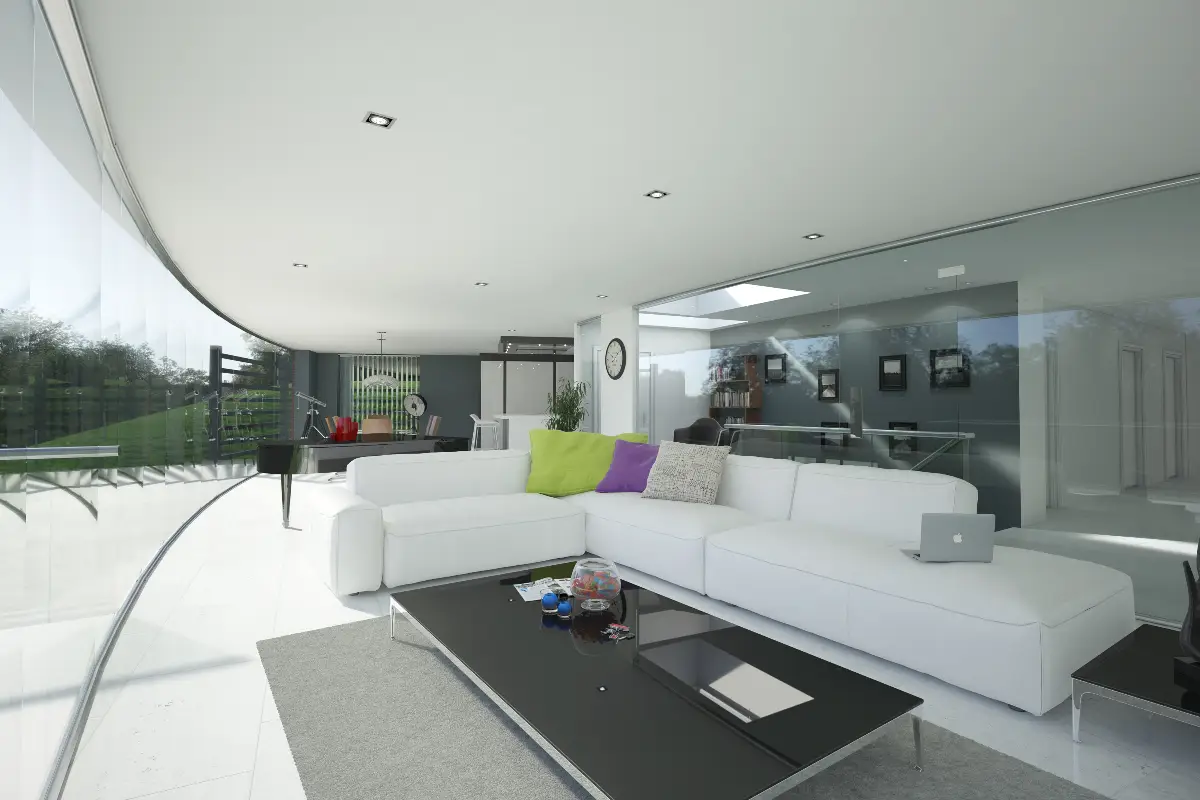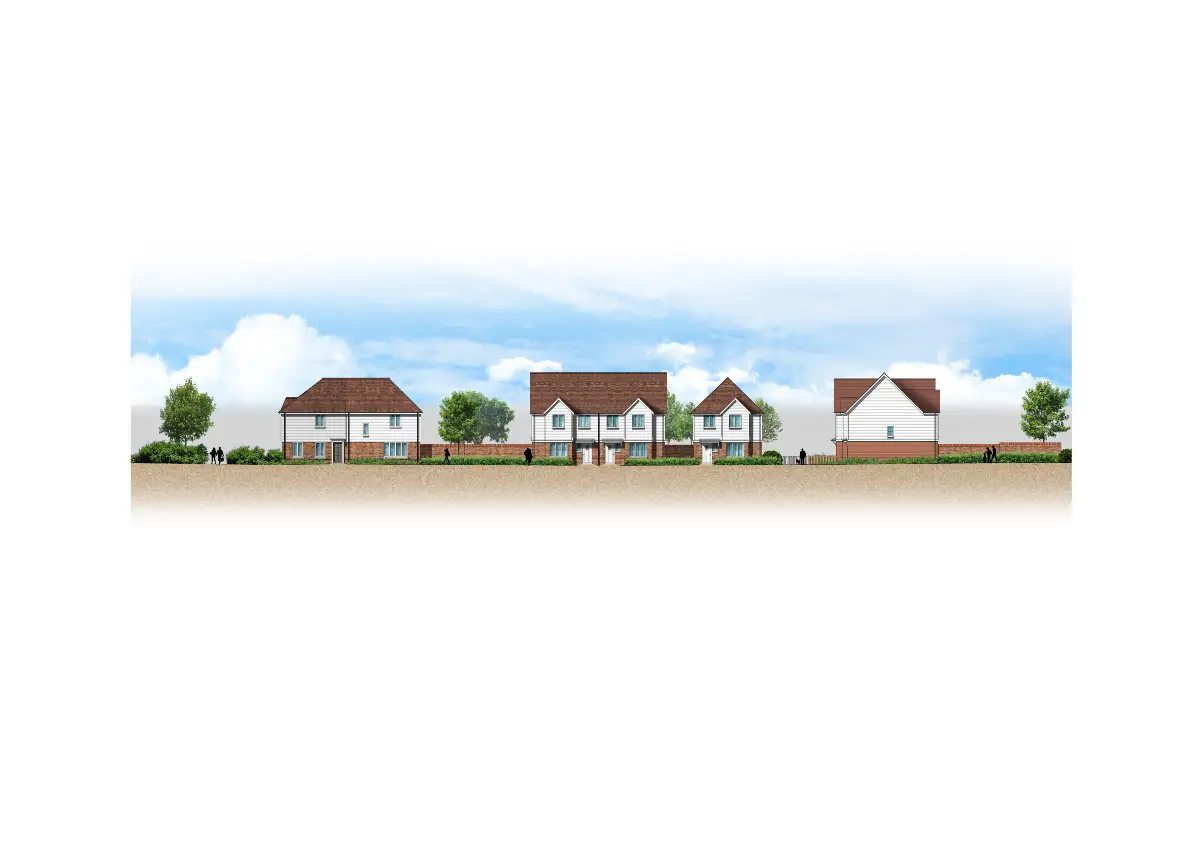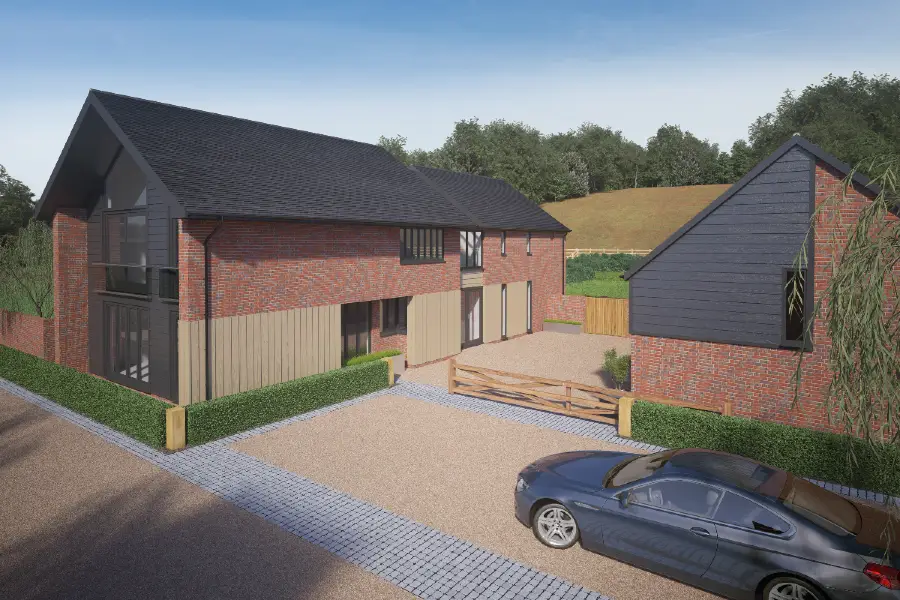Kent Housing Development: A Site-Specific Landmark Scheme
Modern housing development scheme
We worked with our client, a private development company, to transform a dormant site in the Kent Downs Area of Outstanding Natural Beauty (AONB) into an ambitious 38-home scheme.
Originally a modest outline application, the project developed into a complete design for a landscape-led housing development that combines affordable housing, self-build plots, and generous green space.
This site presented some unique challenges, including fragmented land ownership and fierce community resistance.
Through close collaboration with planners and local stakeholders, we delivered a context-driven proposal that the local authority now regards as a model for future residential development.
Appointing Taylor Roberts to Design a Context-sensitive Housing Development
The site, which is located on the western edge of Densole, had sat untouched for years. Because it was split into 100 small plots, which were sold as speculative investments, it seemed impossible to develop.
Our client stepped in and patiently negotiated the purchase of every parcel. After gaining control of the whole site, they faced local opposition and the strict planning restrictions that come with building in an AONB.
Having worked with us on several intricate housing and master planning projects, they brought us in to help them navigate the local politics and design a scheme that the local authority could support.
The Brief
The client’s goal was to create a high-quality new housing development that balanced commercial viability with local benefit.
The scheme needed to deliver affordable housing, self-build opportunities, and open-market homes arranged in a layout that respected the site’s rural edge, village setting, and environmental constraints.
The Design
The vision was to create a residential development that felt deeply rooted in its surroundings and looked like a natural extension of the village, not an imposition on it.
We used an existing public footpath that runs through the site to shape the layout. Rather than rerouting it through streets, we set it in a green corridor to retain its open, rural feel. Clusters of homes are arranged on either side of it, creating a soft, permeable layout that blends with the surrounding landscape.
The site plan mirrors its surroundings: there is denser housing near the built-up eastern edge of the village and a softer, more dispersed arrangement towards the open farmland to the west. This helps the transition from village core to countryside.
The scheme includes a main vehicular access and a smaller secondary access serving a handful of homes along Coach Road. Primary pedestrian links front Canterbury Road.
The Housing Mix
The plan includes 38 dwellings with a mix of affordable and open-market homes, and six self-build plots. 13 of the homes are designated as affordable housing, going beyond local policy requirements.
The six self-build plots, which are located near the site entrance, are open-market properties. Their sale will help support the scheme’s viability.
To maintain consistency, we introduced a design code that sets out materials, roof forms, and key elevations. This ensures visual harmony across the scheme, while allowing for variety in finishes and forms. Each home has its own identity, giving the housing development a village-like character.
The Materials
We chose a palette of materials that reflects the local vernacular and helps the scheme feel rooted in its setting.
Stock brick, clay tiles, and a mix of light and dark weatherboarding give the dwellings a familiar, rural feel without slipping into pastiche.
Along key frontages, we specified brick walls instead of fencing to enhance the street edge and give the development a more settled, cohesive look.
The Landscape Strategy
The site suffers from poor drainage: the ground often becomes saturated in winter. To address this, we introduced a series of seasonal balancing ponds that reduce surface water and local flooding. These are linked by a mix of open ditches and underground pipes, allowing water to move naturally across the site while keeping clear of roads and footpaths.
The ponds sit within generous green spaces, which will be planted with reeds and grasses. Together, these planted areas create a green buffer that supports biodiversity and softens the transition between new development and the countryside.
At the southeastern corner, we introduced a shared space in front of the local pub. It doubles as a village green for the wider community and provides a soft threshold between new development and the existing village.
Finally, at the western edge of the site, we included 11 allotments, which can be used to support local schools or special needs programmes aimed at the local community.
The Planning Application Approval Process
The scheme began as a standard outline application but early community resistance pushed it into a new direction.
At the council’s request, our client brought in an independent Design Review Panel. Guided by their feedback and ongoing discussions with planners and residents, we developed a comprehensive scheme that delivers new housing while positively contributing to the area.
The planning team stayed engaged throughout, keeping the application live during the redesign - something they don’t do often, which showed genuine backing.
While the Section 106 agreement - a legal step that secures affordable housing, open space, and other contributions - is still being finalised, the application has received outline approval.
Next steps
At the time of writing, the client is marketing the site and exploring delivery options.
The Client’s Feedback
Securing Planning approval was a major milestone for the client. Despite the challenges they faced, the result exceeded their expectations.
By combining landscape-led thinking with detailed architectural input, we helped turn a fragmented, dormant site into a viable, well-integrated village extension.
The planning team now sees our scheme as a potential model for new development in the district, as it shows how thoughtful design can respond to planning constraints while blending into a village edge.
If you’re planning a new housing development in Kent or the South East, Taylor Roberts can support you with bespoke architectural and masterplanning services.
We offer end-to-end support: from early feasibility studies and design reviews to detailed planning applications and site-specific housing layouts tailored to complex sites.
Call us on 01227 457 545 or email us on enquiries@taylorroberts.co.uk to discuss your project.
Contact our team today for expert property advice - book now for free.






